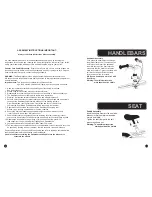
27
4.C - BRakes
There are three general types of bicycle brakes: rim
brakes, which operate by squeezing the wheel rim
between two brake pads; disc brakes, which operate
by squeezing a hub-mounted disc between two
brake pads; and internal hub brakes. All three can
be operated by way of a handlebar mounted lever.
On some models of bicycle, the internal hub brake
is operated by pedaling backwards. This is called a
Coaster Brake and is described on page 30.
WaRninG
1.
Riding with improperly adjusted brakes or worn
brake pads is dangerous and can result in serious
injury or death.
2.
applying brakes too hard or too suddenly can lock
up a wheel, which could cause you to lose control
and fall.
Sudden or excessive application of the front
brake may pitch the rider over the handlebars, which
may result in serious injury or death.
3.
some bicycle brakes, such as disc brakes (fig.
11) and linear-pull brakes (fig.12), are extremely
powerful.
Take extra care in becoming familiar with
these brakes and exercise particular care when using
them.
4.
some bicycle brakes are equipped with a brake
force modulator, a small, cylindrical device through
which the brake control cable runs and which is
designed to provide a more progressive application
of braking force.
A modulator makes the initial brake
lever force more gentle, progressively increasing force
until full force is achieved. If your bike is equipped with
a brake force modulator, take extra care in becoming
familiar with its performance characteristics.
5.
disc brakes can get extremely hot with extended
use. Be careful not to touch a disc brake until it has
had plenty of time to cool.
6.
see the brake manufacturer’s instructions for
installation, operation and care of your brakes.
If
you do not have the manufacturer’s instructions, see
your dealer or contact the brake manufacturer.
1. Brake Controls and features
It’s very important to your safety that you learn and
remember which brake lever controls which brake on
your bike.
For example:
In the US and Europe, The rear brake is controlled
by the right-hand brake lever; the front brake is
controlled by the left-hand lever.
In the United Kingdom and Japan, the rear brake
is controlled by the left lever; the front brake is
controlled by the right lever.
Confirm with your dealer how your bike is set up.
Make sure that your hands can reach and squeeze
the brake levers comfortably. If your hands are too
small to operate the levers comfortably, consult your
dealer before riding the bike. The lever reach may be
adjustable; or you may need a different brake lever
design.
Most brakes have some form of quick-release
mechanism to allow the brake pads to clear the tire
when a wheel is removed or reinstalled. When the
brake quick release is in the open position, the brakes
are inoperative. Ask your dealer to make sure that you
understand the way the brake quick release works on
your bike (see figs. 11, 12, 13, 14 & 15) and check each
time to make sure both brakes work correctly before
you get on the bike.
2. how Brakes Work
The braking action of a bicycle is a function of the
friction between the brake surfaces — usually the
brake pads and the wheel rim. To make sure that you
have maximum friction available, keep your wheel
rims and brake pads clean and free of dirt, lubricants,
waxes or polishes.
Содержание Synapse Carbon
Страница 1: ......
Страница 2: ......
Страница 31: ...29 Figure 11 Figure 12 Figure 13 Figure 14 Figure 15 OPEN OPEN OPEN PUSH...
Страница 65: ...63 This page has been left blank intentionally...
Страница 99: ......
Страница 100: ......
Страница 101: ......
Страница 102: ......
















































